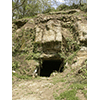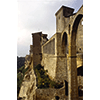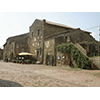Maremma

The great abundance of tuff is responsible for the uniqueness of the Maremma landscape east of the Fiora River. Forever exploited for its construction qualities, this stone of volcanic origin was excavated to make habitations, necropoli, fortresses and communication routes. The volcanic nature of the territory is also tied to the presence of hot and sulphurous springs, which have been exploited for centuries.
Among the numerous tokens of antiquity that have survived until today, including the splendid Etruscan necropolis at Sovana, the medieval town of Vitozza, located some 7 kilometres east of Sorano, has more than 200 dwellings dug into the tuff and is one of the largest rupestrian centres in Italy.

To venture among the lanes recessed in the tufaceous rock is today a rare and fascinating experience. And yet, for the Etruscans who dug these quarry roads, it was perhaps the commonest way to travel the area around Sorano and Pitigliano.
Tufa undisputedly dominates the landscape of this corner of southern Tuscany, and in the course of history, its inhabitants learned to wisely exploit this soft stone in order to excavate streets, tombs and even houses.
Vitozza is the monument and symbol of this civilisation. With its more than 200 caves, it is today one of the largest rupestrian centres of Central Italy. The town lived its moment of greatest fortune between the 13th and 14th century with the construction of the walls, church and fortress, the only buildings with elevations in town. All of the dwellings were indeed entirely excavated in tufa, and often have two or more storeys. Even the interior furnishings (niches, wardrobes, dining-tables) were meticulously carved into the rock bed.
Definitively abandoned in the 18th century, the city is today a "Pompeii in tufa", an archaeological park that can be easily visited, thanks to recent restoration that has also permitted the realisation of excellently outfitted footpaths.
Good walkers may also find it interesting to visit the remains of the walls of the Vitozza-Sorano aqueduct, built very soon after the Unification of Italy, and visible along the course of the Lente River.
(Elena Fani)
About 10 km away along SS74/SR74, the series of arches in tuff of the aqueduct announces Pitigliano and a spectacular example of construction and hydraulic engineering of the Medici and Lorraine epoch.

Built on a project by Antonio da Sangallo the Younger and dating to the 16th century, the old aqueduct of Pitigliano is formed by two large arches supported by an enormous pilaster in tufa, dating to the Medicean period, and by thirteen little arches erected during the Lorraine period. The scenographic construction rises sheer over the tufa cliffs. Three fountains in the adjoining Piazza della Repubblica constitute the terminal of the aqueduct. It is well worth following the itinerary along the town streets, with its characteristic houses "suspended" on the tufa crag.
(Graziano Magrini)
Only a few kilometres on SP46 and SP22 separate Pitigliano from Sovana, an enchanting little medieval village which, in an eleventh-century palazzo, houses an important terrestrial malacological collection, the first of its kind in Italy.

For its very singular nature, the Museum of Terrestrial Malacology, housed in an ancient eleventh-century building, may be considered unique of its kind in Italy. Founded in 1988 by the International Malacology Association, headquartered in Rome, it is the result of years of research and studies on the relationship between terrestrial molluscs, plants and the environment, especially as regards mountainous zones and inland waterways.
The exhibition, displayed on two floors, consists of four large exhibition areas divided according to geographical areas. The collection includes, in addition to showcases containing the shells of terrestrial molluscs, large terrariums and aquariums with live specimens. In particular, there are shells of molluscs coming from tropical forests, from rivers, lakes, swamps, dry and wooded zones all over the world. Noteworthy are some rare specimens, including some that are now extinct and others found only in sub-fossil form.
(Stefania Mangia)
Though not owing its fame to tuff, but to the territory’s mineral resources, the spa locality of Saturnia abounds in travertine. It is located about 20 km further on along SP22.
The thermal baths of Saturnia have very ancient origins, as proven by Etruscan remains found in the area. The baths were appreciated by the Romans too, who made them a resting station along the Via Clodia. In the Middle Ages Saturnia, like many other thermal centres, underwent a stage of decline. In the following centuries, its fortunes alternated. At the end of the 18th century the naturalist Giorgio Santi, describing the territory of the two Sienese provinces (Grosseto and Siena) in his Viaggio secondo per le due provincie Senesi, mentioned the "ruined and deserted Saturnia", whose waters had been utilised, since the most remote times, to treat the diseases of men as well as those of animals: "They come to make use of these Baths by immersion, both Men, and Cattle, they being credited with the cure of skin diseases. The mud filled with Sulphur deposited by the water in the great Basin is gathered, reduced to small round masses, and sold dried to the Shepherds, who then soak it in water and rub it on the scabious Sheep, and due to the effect of the Sulphur, often with good success."
Santi not only described the Baths of Saturnia and the Holy Bath, but also formulated a hypothesis on the origin of the travertine rocks so abundant in that area: "The aspect of the Travertines leads me to believe, correctly I think, that in very ancient times, even before the foundation of Saturnia, there flowed from the high and level top of that hill the water of the present-day Baths which, here accumulating encrustations, and sediments, went to form those masses of Travertine, which, by building up in layers and expanding, finally obstructed the Springs, and blocked the course of their waters; which thus obliged to find a path elsewhere, had to gush out in the adjacent plain, where they are found today, to then again with the passage of time undergo new obstructions, and new changes of site."
In the early 20th century, thanks to better environmental conditions, the malaria that had plagued the Maremma in the past having been overcome, the baths were entirely rebuilt, becoming an important and spectacular site of thermal tourism. Today the waters and mud-packs of Saturnia, famous the world over, are used to treat numerous diseases.
(Graziano Magrini)
****************************
Texts by Elena Fani
English translation by Victor Beard
Last update 09/feb/2008



 = libraries and archives
= libraries and archives  = scientific research centers
= scientific research centers  = memorial places of scientists
= memorial places of scientists = public health places
= public health places = places of science and worship
= places of science and worship = places of technology
= places of technology  = museums and collections
= museums and collections  = villas and gardens of science
= villas and gardens of science


